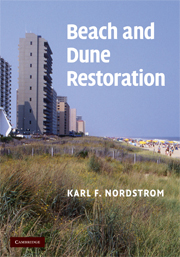Book contents
- Frontmatter
- Contents
- Preface
- Acknowledgments
- 1 The need for restoration
- 2 Beach nourishment and impacts
- 3 Dune building practices and impacts
- 4 Restoring processes, structure, and functions
- 5 Options in spatially restricted environments
- 6 A locally based program for beach and dune restoration
- 7 Stakeholder interests, conflicts, and co-operation
- 8 Research needs
- References
- Index
6 - A locally based program for beach and dune restoration
Published online by Cambridge University Press: 14 August 2009
- Frontmatter
- Contents
- Preface
- Acknowledgments
- 1 The need for restoration
- 2 Beach nourishment and impacts
- 3 Dune building practices and impacts
- 4 Restoring processes, structure, and functions
- 5 Options in spatially restricted environments
- 6 A locally based program for beach and dune restoration
- 7 Stakeholder interests, conflicts, and co-operation
- 8 Research needs
- References
- Index
Summary
The need for local action
Addressing the main causes of decline in the health of ecosystems, such as eutrophication, can be beyond the capability of individual management units, but local management measures can be used to restore individual components of the landscape (Verstrael and van Dijk 1996). The expression “think globally, act locally” is as appropriate to coastal restoration as it is to addressing problems of pollution or water management. Local actions are often critical in optimizing the value of projects and plans developed by higher authorities (De Ruyck et al. 2001). Large-scale beach and dune construction projects are usually funded, designed, and built by governments at the national and state/provincial level and tend to be capital-intensive, with minimal maintenance costs (Townend and Fleming 1991), without follow-up monitoring or maintenance, or performance criteria based on considerations for natural habitats. Management of beaches and dunes created in these projects is often controlled by local jurisdictions. Locally based programs are needed to ensure that these projects achieve their full restoration potential.
An integrated, locally based program for increasing the number, size, and usefulness of natural environments in developed areas involves (1) getting stakeholders to accept natural landforms and habitats as appropriate elements in a human-modified coastal landscape; (2) identifying environmental indicators and target reference conditions using characteristics of existing natural enclaves; (3) establishing demonstration sites to evaluate the positive and negative effects of return to a more dynamic system; (4) developing realistic guidelines and protocols for use in restoring and managing landforms and habitats in other locations; (5) changing stakeholder preferences to favor restoration initiatives; and (6) developing environmental education programs to establish an appreciation for new naturally-functioning landscape components (Nordstrom 2003).
Information
- Type
- Chapter
- Information
- Beach and Dune Restoration , pp. 107 - 128Publisher: Cambridge University PressPrint publication year: 2008
Accessibility standard: Unknown
Why this information is here
This section outlines the accessibility features of this content - including support for screen readers, full keyboard navigation and high-contrast display options. This may not be relevant for you.Accessibility Information
- 1
- Cited by
